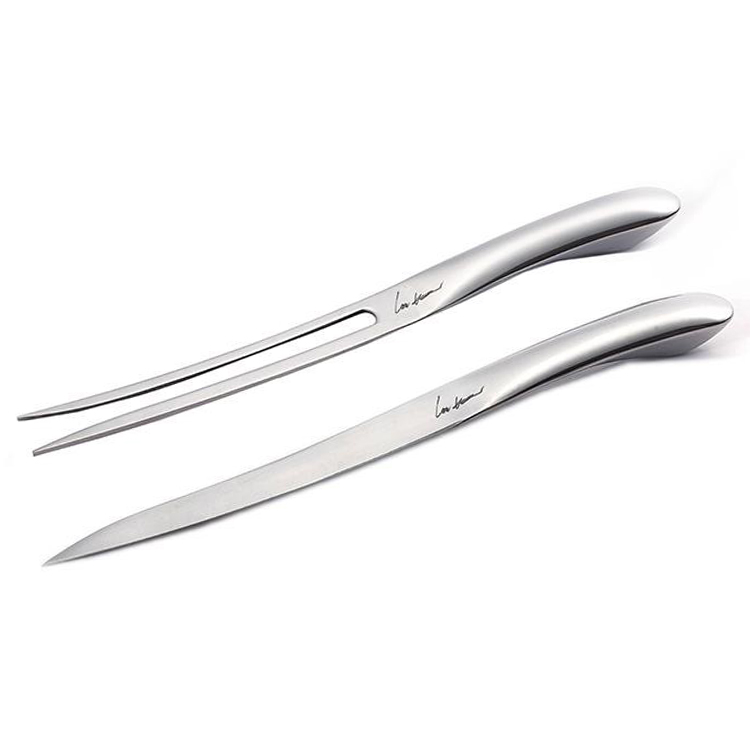Views: 290 Author: Site Editor Publish Time: 2025-11-04 Origin: Site











Content Menu
● What is a Carving Knife and Fork Set?
>> Features of a Good Carving Knife and Fork Set
● Types of Carving Knife and Fork Sets
● How to Use a Carving Knife and Fork Set
● Maintenance Tips for Your Carving Knife and Fork Set
● Popular Brands of Carving Knife and Fork Sets
>> 1. Wüsthof
>> 4. Shun
A carving knife and fork set typically includes a long, sharp knife designed for slicing meats and a fork with long tines to hold the meat steady while carving. This combination allows for precise cuts and a more elegant presentation of your dishes.
When selecting a carving knife and fork set, consider the following features:
- Blade Material: High-quality stainless steel is preferred for its durability and resistance to rust. Some sets use high-carbon steel for sharper edges.
- Handle Design: Ergonomic handles provide comfort and control during use. Look for materials that offer a good grip, such as wood or synthetic composites.
- Length of the Knife: A longer blade (typically 8 to 14 inches) allows for smoother, more even cuts.
- Fork Tines: The fork should have sturdy, long tines to securely hold the meat in place.
Traditional carving knife and fork sets are often made from high-quality stainless steel and feature classic designs. They are perfect for formal occasions and can be passed down through generations.
Modern sets may incorporate innovative materials and designs, such as ceramic blades or ergonomic handles. These sets are often lighter and easier to handle, making them suitable for everyday use.
Electric carving knives are designed for ease of use, especially when carving larger cuts of meat. They typically come with a fork for stability and can make the carving process quicker and less labor-intensive.
Using a carving knife and fork set effectively requires some technique. Here are some steps to follow:
1. Prepare the Meat: Allow the meat to rest after cooking. This helps retain juices and makes carving easier.
2. Secure the Meat: Use the carving fork to hold the meat steady on a cutting board.
3. Slice with Precision: Start at one end of the meat and use smooth, even strokes to slice. Avoid sawing back and forth, as this can tear the meat.
4. Serve with Style: Arrange the slices on a platter for an appealing presentation.
To ensure the longevity of your carving knife and fork set, follow these maintenance tips:
- Cleaning: Hand wash your knives and forks with warm, soapy water. Avoid using a dishwasher, as it can dull the blades.
- Sharpening: Regularly sharpen your knife to maintain its cutting edge. Use a whetstone or a professional sharpening service.
- Storage: Store your set in a knife block or a protective sheath to prevent damage to the blades.
Wüsthof is renowned for its high-quality German knives. Their carving sets are known for their precision and durability.
This brand offers a variety of carving knife and fork sets that combine traditional craftsmanship with modern technology.
Victorinox is famous for its Swiss Army knives, but they also produce excellent carving sets that are both affordable and reliable.
Shun knives are handcrafted in Japan and are known for their sharpness and beautiful designs. Their carving sets are a favorite among professional chefs.
A carving knife and fork set is an indispensable tool for anyone who enjoys cooking and entertaining. Whether you opt for a traditional set or a modern electric version, the right tools can make all the difference in your culinary experience. By understanding the features, types, and maintenance of these sets, you can choose the perfect one for your kitchen.

1. What is the best material for a carving knife?
- High-carbon stainless steel is often considered the best material due to its sharpness and durability.
2. How do I sharpen my carving knife?
- Use a whetstone or a honing rod to sharpen your knife regularly, ensuring it maintains a sharp edge.
3. Can I use a carving knife for other types of food?
- While carving knives are designed for meats, they can also be used for slicing large fruits and vegetables.
4. How should I store my carving knife and fork set?
- Store them in a knife block, magnetic strip, or protective sheaths to prevent damage.
5. What is the difference between a carving knife and a chef's knife?
- A carving knife is longer and thinner, designed specifically for slicing meats, while a chef's knife is more versatile for various kitchen tasks.